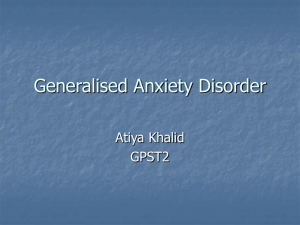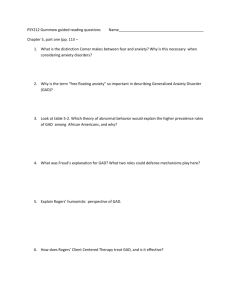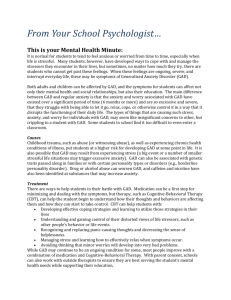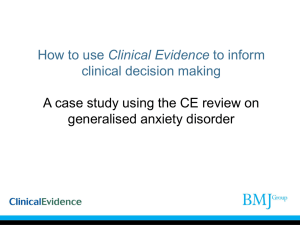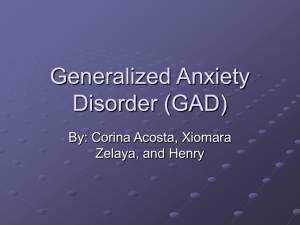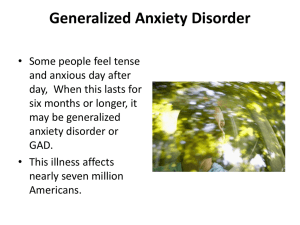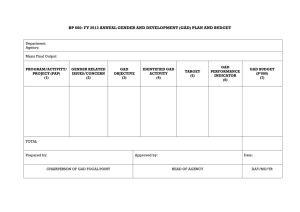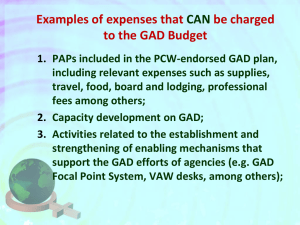CG113 Anxiety (partial update): Slide set
advertisement
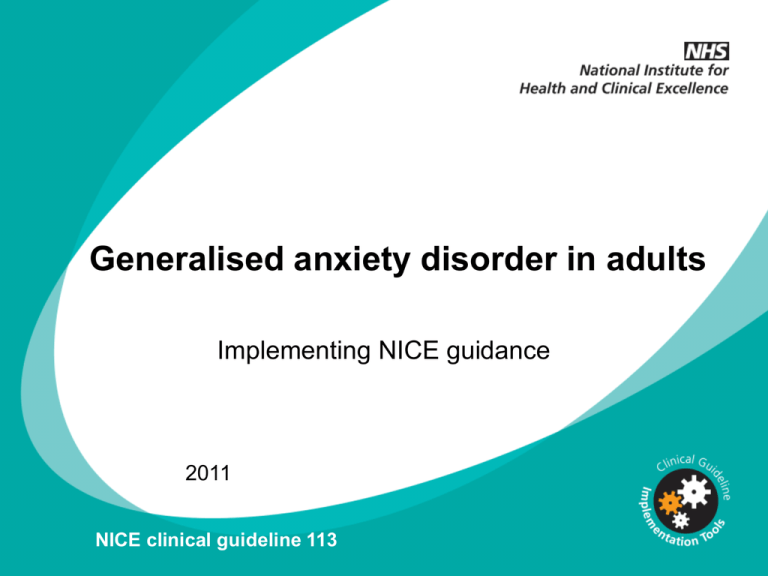
Generalised anxiety disorder in adults Implementing NICE guidance 2011 NICE clinical guideline 113 Updated guidance This guideline updates and replaces ‘Management of anxiety’, NICE clinical guideline 22. (published December 2004; amended April 2007) Only the recommendations for the management of generalised anxiety disorder (GAD) have been updated. This presentation focuses only on the key recommendations for GAD. What this presentation covers Background Scope Key recommendations Costs and savings Discussion Find out more Background • Generalised anxiety disorder is common. • The central feature is excessive worry about a number of events associated with heightened tension. • The goal of an intervention should be complete relief of symptoms. Scope Care, treatment and support for adults (aged 18 and over) with GAD or panic disorder, and their families or carers. Management in primary, secondary and community care. Stepped care for people with GAD Step 1 Identification and assessment; education about GAD and treatment options; active monitoring Step 2 Low-intensity psychological interventions: individual nonfacilitated self-help, individual guided self-help and psychoeducational groups Step 3 Choice of a high-intensity psychological intervention (cognitive behavioural therapy/applied relaxation) or a drug treatment Step 4 Highly specialist treatment, such as complex drug and/or psychological treatment regimens; input from multi-agency teams, crisis services, day hospitals or inpatient care Step 1: Identification For all known and suspected presentations of GAD: • Identify and communicate the diagnosis of GAD early. • Consider a diagnosis of GAD in people presenting with significant worry or who attend primary care frequently because of a chronic physical health problem or somatic symptoms. Step 1: Education, treatment and monitoring Following assessment and diagnosis of GAD: • provide education about GAD and options for treatment • monitor symptoms and functioning (known as active monitoring). Discuss the use of over-the-counter medications and preparations. Step 2: Low-intensity psychological interventions For people with GAD that has not improved after education and active monitoring in step 1, offer one or more of the following, guided by the person’s preference: • individual non-facilitated self-help* • individual guided self-help • psychoeducational groups. Step 3: High-intensity treatment For people with GAD with marked functional impairment or that has not improved after step 2 interventions offer either: • an individual high-intensity psychological intervention using either CBT or applied relaxation or • drug treatment using a selective serotonin reuptake inhibitor (consider offering sertraline first because it is the most cost-effective drug)* Do not offer antipsychotics for GAD in primary care. Do not offer benzodiazepines except as a short-term crisis measure. *At January 2011, sertraline did not have UK marketing authorisation for this indication. Informed consent should be obtained and documented. Monitor the person carefully for adverse reactions Inadequate response to step 3 interventions If a person’s GAD has not responded to: • a high-intensity psychological intervention, then offer a drug treatment • drug treatment, then offer either a high-intensity psychological intervention or an alternative drug treatment. If a person’s GAD has partially responded to drug treatment, consider offering a high-intensity psychological intervention in addition to drug treatment. Referral to step 4 Consider referral to step 4 if the person has severe anxiety with marked functional impairment and: • a risk of self-harm or suicide or • significant comorbidity or • self-neglect or • an inadequate response to step 3 interventions. Step 4: Highly specialist treatment Consider offering combinations of treatment: • psychological and drug treatments or • combinations of antidepressants or • augmentation of antidepressants with other drugs. But exercise caution and be aware of the lack of evidence of effectiveness and increased risk of side effects. Costs and savings The revised recommendations are unlikely to result in a significant change in resource use in the NHS at a national level. Because of variations in practice across the country, organisations may incur costs or savings depending on their circumstances. Using the stepped-care model allows less intensive low-cost psychological interventions to be used first and if people do not improve then to step up to SSRI medication or more expensive highly intensive psychological interventions. Early intervention and the use of the stepped-care approach will lead to a more effective use of resources. Discussion • What training is needed to enable all professionals to improve their identification of GAD? • What low-intensity psychological interventions are available for people with GAD and how are they accessed? • What high-intensity psychological interventions are available for us to refer people with GAD to? • How should our prescribing change following this guidance? Find out more Visit www.nice.org.uk/guidance/CG113 for: • • • • • • • • the guideline the quick reference guide ‘Understanding NICE guidance’ costing statement audit support baseline assessment tool clinical case scenarios guide to resources for service users What do you think? Did the implementation tool you accessed today meet your requirements, and will it help you to put the NICE guidance into practice? We value your opinion and are looking for ways to improve our tools. Please complete a short evaluation form by clicking here. If you are experiencing problems accessing or using this tool, please email implementation@nice.org.uk
